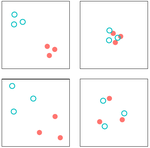Abstract
Interspecific spatial associations (ISA), which include co-occurrences, segregations, or attractions among two or more species, can provide important insights into the spatial structuring of communities. However, ISA has primarily been examined in the context of understanding interspecific interactions, while other aspects of ISA, including its relations to other biodiversity facets and how it changes in the face of anthropogenic pressures, have been largely neglected. This is likely because it is unclear what makes ISA useful in a biodiversity context, little is known about the theoretical connections between ISA and other biodiversity facets, and there is a confusing variety of approaches to measuring ISA.
Here, we first review the metrics of ISA. These include spatially implicit and explicit indices of association for binary, abundance, and point pattern data. We test and compare these approaches on empirical and simulated data, and we provide recommendations for how to use and interpret them in biodiversity science. We argue that measurements of ISA are more informative when they are spatially explicit (i.e., distance dependent). We then review links of ISA to other classical biodiversity facets, such as alpha, beta, and gamma diversity, and show that they mostly fail to reflect changes/variation in ISA, with the exception of average pairwise beta diversity. This underscores the need for a specific focus on ISA in large-scale biodiversity assessments. Finally, we argue that there are important, and underappreciated, reasons to study ISA that are unrelated to its link to biotic interactions. Specifically, ISA can provide strong tests of biodiversity theories that require multiple patterns to benchmark against, and it can be explored for potentially predictive macroecological patterns.
